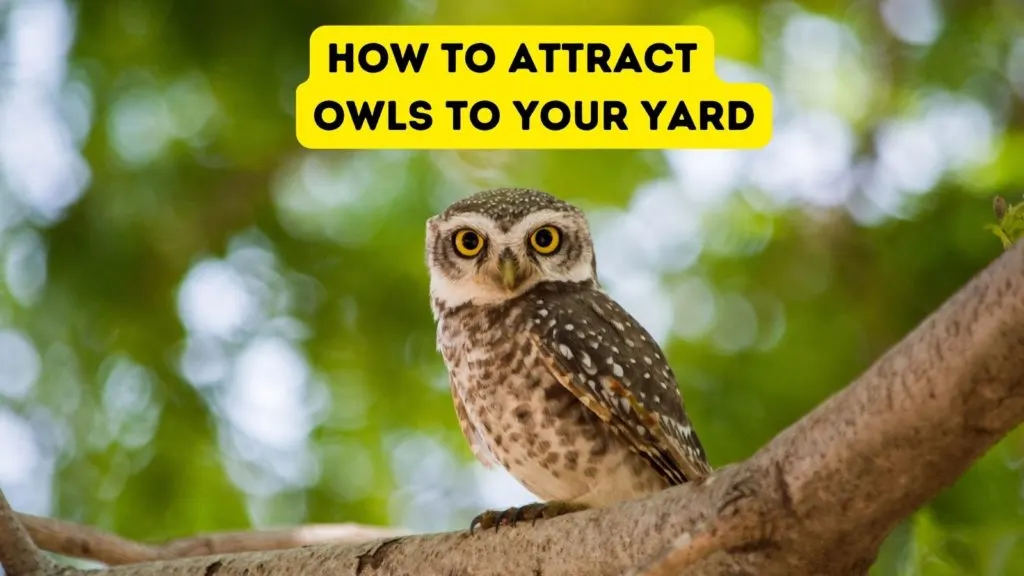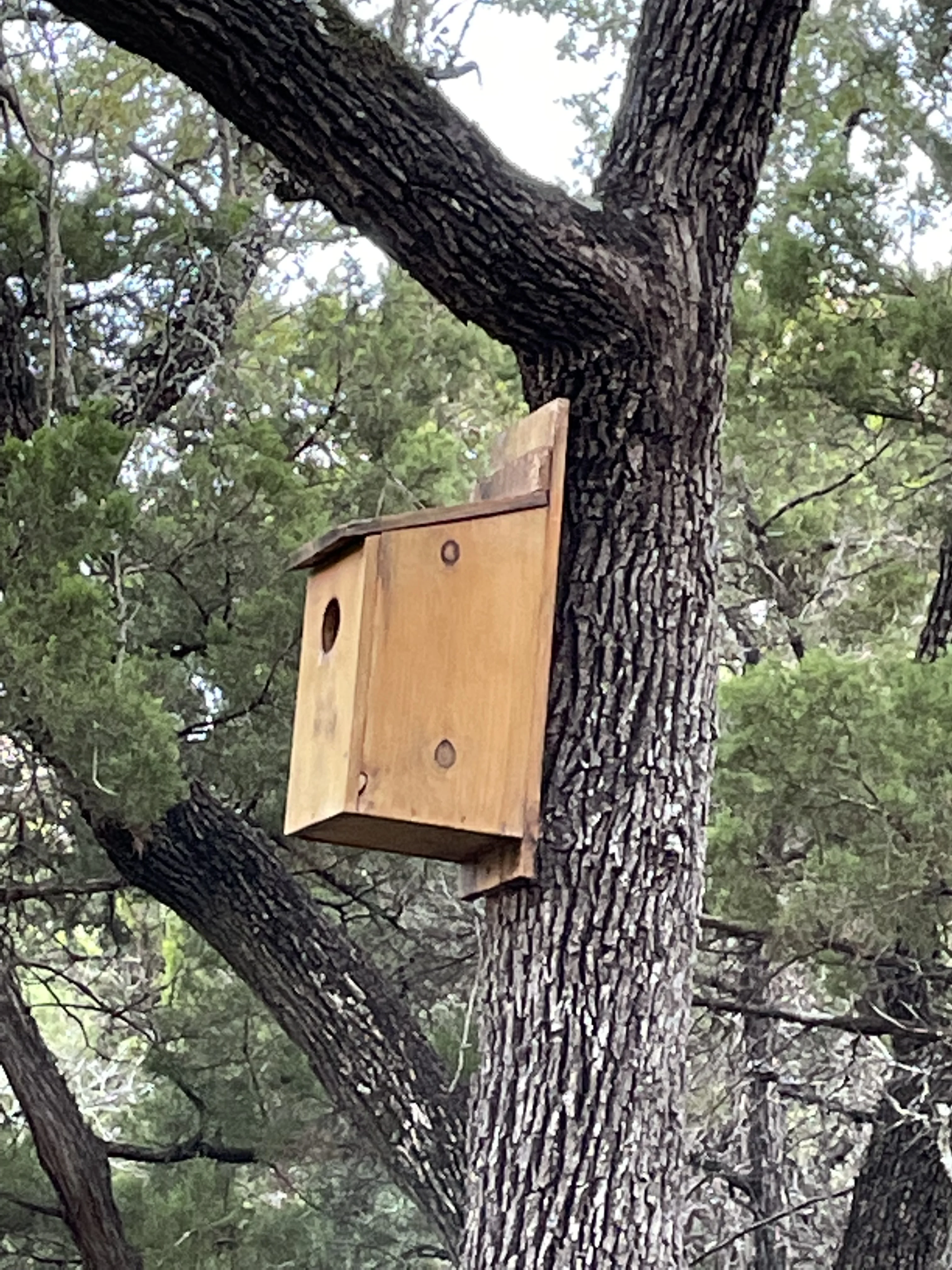We are lucky enough to have many owls nearby. They hunt in the evening (and we’ve even seen small owls hunting in the creek at night when there’s water!) Attracting owls to your backyard can be a rewarding experience, offering unique opportunities to observe these fascinating nocturnal predators in their natural habitat. Owls play a crucial role in maintaining the balance of ecosystems by controlling rodent and insect populations.

Nighttime bird watching presents an opportunity to encounter species that remain elusive during the day, engaging not just our sight but our hearing as well. We love listening both to owls and, during warm weather months, Chuck-will’s-widows in our yard.
How to Attract Owls to Your Backyard
Here are some tips on how to make your backyard more appealing to owls.
Provide Natural Habitat Features
- Preserve Mature Trees: Owls prefer to nest in mature trees with dense foliage that offer protection and good vantage points. If you have large trees in your yard, preserving them can make your space more attractive to owls.
- Leave Snags Standing: Dead trees or snags provide essential nesting and roosting spots for owls. If they’re not a safety hazard, consider leaving them in your yard. Thanks to a terrible ice storm (which followed a terrible drought) we have multiple dead trees around our house (especially near the creek). We’ve left many of them and the birds couldn’t be happier.
- Brush Piles: Creating brush piles provides shelter for small mammals, which in turn can attract owls looking for food. We’ve got far more brush around our house than we ever planned on thanks to that huge ice storm–but the birds love it!
Enhance Food Sources
- Natural Prey Population: Avoid using pesticides in your garden to ensure there’s a healthy population of insects, rodents, and other small animals for owls to feed on.
- Water Sources: A pond or a bird bath can attract owls indirectly by supporting a diverse ecosystem in your yard, including prey for owls. And, of course, owls and other nocturnal birds need water, too, and will come drink at your bird bath.
Install Owl Nesting Boxes

- Suitable Boxes: Install nesting boxes designed specifically for the owl species native to your area. Place them high up in trees and away from busy human activity. Our neighbors have owl boxes along their trails; they’re very high up in the trees with a wide open area in front of the boxes so the owl can swoop in and out without difficulty.
- Proper Placement: Ensure the box is placed in a quiet part of the garden, ideally facing away from prevailing winds and with a clear flight path for the owls.
Minimize Human Disturbance
- Keep Pets Indoors at Night: Pets can scare away owls or pose a threat to them, so it’s best to keep pets indoors during the evening and night. (And it’s the safest thing for your pets as well!)
- Reduce Noise and Light Pollution: Minimize outdoor lighting and keep noise levels low to create a more welcoming environment for nocturnal wildlife like owls.
Promote a Safe Environment
- Protect from Predators: Make sure the nesting boxes and habitat areas are safe from common predators, including domestic cats and larger birds of prey.
- Use Natural Fencing: Natural barriers like hedges can provide safe nesting areas and protect owls from predators.
Be Patient
Attracting owls to your backyard can take time. Owls are territorial and will only settle in a new area if it meets their needs for food, shelter, and safety. Maintaining a natural and safe habitat is key to eventually hosting these remarkable birds.
Preparing for Nocturnal Bird Watching
To embark on a nocturnal bird watching adventure, preparation is key. Binoculars with a good low-light performance are also beneficial, although much of your observation might rely more on auditory cues than visual ones. Dress appropriately for the time of year, opting for quiet, warm layers that allow you to move silently through your yard–or just pull up a lawn chair and sit quietly as you wait for the party to begin.
Game cameras can be a great way to see what nighttime visitors you have had in your yard, at your feeder or at your bird bath. We have several game cameras and keep one pointed on our bird bath.
Using a game camera with night vision is an excellent method for observing owls and other nocturnal birds in their natural habitats without disturbing them. These cameras, equipped with motion sensors and infrared technology, can capture high-quality images and videos of wildlife under the cloak of darkness.
When strategically placed near potential owl nesting sites, perches, or feeding areas in your backyard, a night vision game camera can provide fascinating insights into the nightly activities of these elusive creatures. It allows you to document their hunting behaviors, interaction with other birds, and even the adorable moments of owlets playing or being fed by their parents.
This non-intrusive way of monitoring offers bird enthusiasts a unique window into the nocturnal world of birds, enriching our understanding and appreciation of their lives beyond the daylight hours.
Learning to Listen
While spotting birds at night can be challenging, the sounds of the night offer clues to the presence of our nocturnal friends. Familiarize yourself with the calls and songs of nocturnal birds in your area.
Each owl species has a distinctive call, from the deep, soft hoots of the Great Horned Owl to the rapid, musical trills of the Eastern Screech-Owl.
Nightjars, another group of nocturnal birds, contribute to the nighttime chorus with their remarkable vocalizations. The Common Nighthawk, for instance, emits a buzzy “peent” sound, while the Whip-poor-will’s call, a rapid, rhythmic chant that can go on for hours, is unmistakable. The Chuck-will’s-widow that call central Texas home literally sound like they’re saying “Chuck Will’s widow” as they sing!
I use the Merlin Bird ID app from Cornell University; the “Sound ID” function can identify birds by song and calls. The app is free and a lot of fun to use! You’ll just turn on your phone’s microphone via the app so it can listen for bird sounds; when it picks up a bird sound, it will identify the bird.
Observing Nocturnal Birds
Observation of nocturnal birds requires patience and a bit of strategy.
Set up a comfortable, quiet spot in your yard where you can sit undisturbed and blend into the surroundings.
Use your ears as much as your eyes to detect the presence of birds. When you hear a bird, remain still and patient; often, your eyes will gradually adapt to the darkness, allowing you to catch glimpses of the bird as it moves.
The Ethical Birdwatcher’s Creed
As with all wildlife observation, respecting the creatures you’re observing is paramount. Keep a respectful distance, avoid using recordings to attract birds, and ensure your presence doesn’t cause stress or harm to the birds. Don’t use flashlights or camera flashes which will frighten the birds and impact their vital night vision.
Watching and listening to owls and other nocturnal birds in your yard opens up a window into the natural world that thrives under the cover of night. It’s a reminder of the complexity and beauty of ecosystems that operate on a different schedule than our own!
More Posts You Might Like
What is the Collective Noun for Owls?
- 8 Letter Bird Names - August 14, 2024
- 7 Letter Bird Names - August 14, 2024
- 7 Birds Named After Famous People - July 23, 2024
